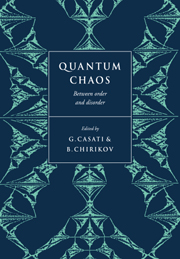Book contents
- Frontmatter
- Contents
- Preface
- Acknowledgments
- Introduction
- Part One Classical chaos and quantum localization
- Stochastic behaviour of a quantum pendulum under a periodic perturbation
- Quantum dynamics of a nonintegrable system
- Excitation of molecular rotation by periodic microwave pulses. A testing ground for Anderson localization
- Localization of diffusive excitation in multi-level systems
- Classical and quantum chaos for a kicked top
- Self-similarity in quantum dynamics
- Time irreversibility of classically chaotic quantum dynamics
- Effect of noise on time-dependent quantum chaos
- Dynamical localization, dissipation and noise
- Maximum entropy models and quantum transmssion in disordered systems
- Solid state “atoms” in intense oscillating fields
- Part Two Atoms in strong fields
- Part Three Semiclassical approximations
- Part Four Level statistics and random matrix theory
- Index
Maximum entropy models and quantum transmssion in disordered systems
Published online by Cambridge University Press: 07 May 2010
- Frontmatter
- Contents
- Preface
- Acknowledgments
- Introduction
- Part One Classical chaos and quantum localization
- Stochastic behaviour of a quantum pendulum under a periodic perturbation
- Quantum dynamics of a nonintegrable system
- Excitation of molecular rotation by periodic microwave pulses. A testing ground for Anderson localization
- Localization of diffusive excitation in multi-level systems
- Classical and quantum chaos for a kicked top
- Self-similarity in quantum dynamics
- Time irreversibility of classically chaotic quantum dynamics
- Effect of noise on time-dependent quantum chaos
- Dynamical localization, dissipation and noise
- Maximum entropy models and quantum transmssion in disordered systems
- Solid state “atoms” in intense oscillating fields
- Part Two Atoms in strong fields
- Part Three Semiclassical approximations
- Part Four Level statistics and random matrix theory
- Index
Summary
Abstract
We consider the conductance g of disordered systems where the electronic quantum coherence extends over a large scale. In the first part, we show characteristic conductance fluctuations driven by a variation of the applied magnetic field B or of the Fermi energy EF, which have been observed at very low temperature in a mesoscopic wire where the carrier density is controlled by a gate. Following the gate voltage, the wire is a conductor (g ≫ 1) or an insulator (g ≪ 1). The fluctuations of g have a normal distribution with a universal variance for conductors and a very large log-normal distribution for insulators. In a macroscopic insulator, the magnetoconductance is mostly governed by the field dependence of the localization length §. In the second part, we review a random matrix theory adapted to the transfer matrix. This macroscopic approach to quantum transmission allows us to describe in a unified and simple way the conductance fluctuations observed in conductors and insulators, and to predict new universal symmetry breaking effects on the variance of g and on §. This approach, based on symmetry considerations and on a maximum entropy criterion, gives the eigenvalue distribution of t.t (t is the transmission matrix) in terms of a simple Coulomb gas analogy. In quasi-one dimension, the analogy is valid for conductors and insulators. Outside quasi-one dimension, we derive analytically the eigenvalue correlation functions of our maximum entropy model that we compare to their direct numerical evaluations from microscopic hamiltonians.
- Type
- Chapter
- Information
- Quantum ChaosBetween Order and Disorder, pp. 185 - 208Publisher: Cambridge University PressPrint publication year: 1995

